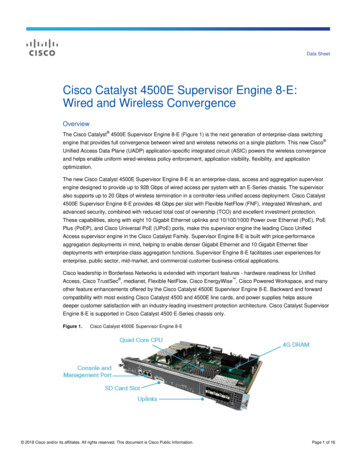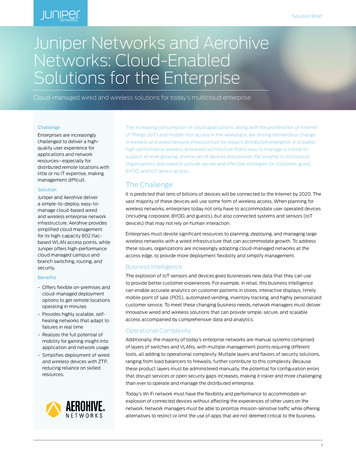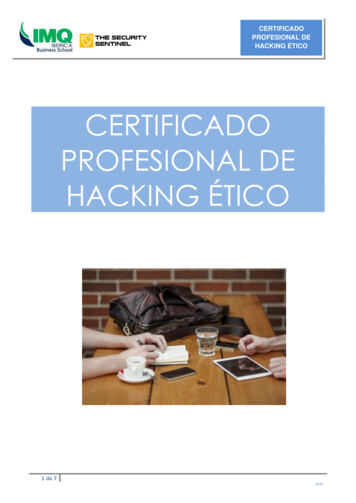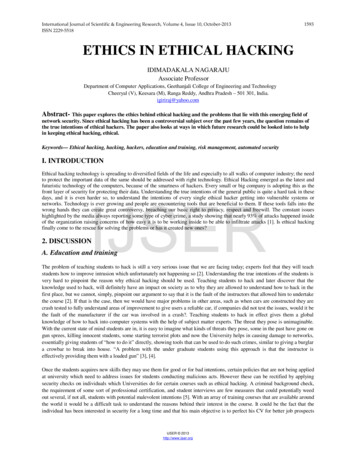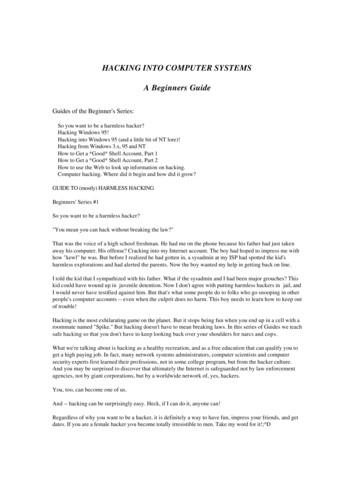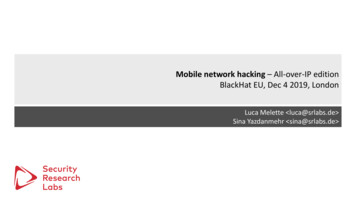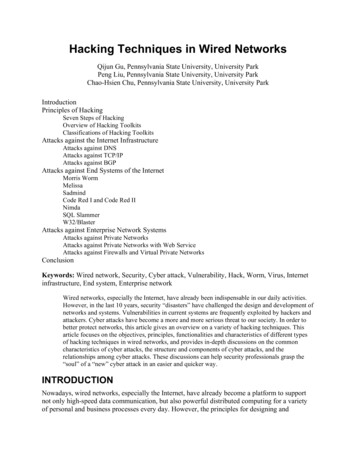
Transcription
Hacking Techniques in Wired NetworksQijun Gu, Pennsylvania State University, University ParkPeng Liu, Pennsylvania State University, University ParkChao-Hsien Chu, Pennsylvania State University, University ParkIntroductionPrinciples of HackingSeven Steps of HackingOverview of Hacking ToolkitsClassifications of Hacking ToolkitsAttacks against the Internet InfrastructureAttacks against DNSAttacks against TCP/IPAttacks against BGPAttacks against End Systems of the InternetMorris WormMelissaSadmindCode Red I and Code Red IINimdaSQL SlammerW32/BlasterAttacks against Enterprise Network SystemsAttacks against Private NetworksAttacks against Private Networks with Web ServiceAttacks against Firewalls and Virtual Private NetworksConclusionKeywords: Wired network, Security, Cyber attack, Vulnerability, Hack, Worm, Virus, Internetinfrastructure, End system, Enterprise networkWired networks, especially the Internet, have already been indispensable in our daily activities.However, in the last 10 years, security “disasters” have challenged the design and development ofnetworks and systems. Vulnerabilities in current systems are frequently exploited by hackers andattackers. Cyber attacks have become a more and more serious threat to our society. In order tobetter protect networks, this article gives an overview on a variety of hacking techniques. Thisarticle focuses on the objectives, principles, functionalities and characteristics of different typesof hacking techniques in wired networks, and provides in-depth discussions on the commoncharacteristics of cyber attacks, the structure and components of cyber attacks, and therelationships among cyber attacks. These discussions can help security professionals grasp the“soul” of a “new” cyber attack in an easier and quicker way.INTRODUCTIONNowadays, wired networks, especially the Internet, have already become a platform to supportnot only high-speed data communication, but also powerful distributed computing for a varietyof personal and business processes every day. However, the principles for designing and
developing a network mainly targeted at providing connection and communication capabilities,until a series of security “disasters” happened on the Internet recently as shown in Figure 1. As aresult, without making security an inherent part of the network design and development process,existing networks are very vulnerable to cyber attacks because of various security vulnerabilities.Such vulnerabilities, when being exploited by the hacker, can motivate the development of avariety of hacking techniques. These hacking techniques directly lead to cyber attacks; and thesecyber attacks have become a more and more serious threat to our society.Reported VulnerabilitiesReported ,0004000300020001000001995 1996 1997 1998 1999 2000 2001 2002 20031995 1996 1997 1998 1999 2000 2001 2002 2003YearYearFigure 1. Reported Incidents and Vulnerabilities from 1995 to 2003 [11]In order to better protect networks, this article tries to give an overview on a variety ofhacking techniques. No wonder, the better we understand the hacker, the better networks can beprotected. This article will focus on the objectives, principles, functionalities and characteristicsof different types of hacking techniques in wired networks, but will not address detailed and indepth hacking processes, which can be found in several other articles of this handbook. Inaddition, we only discuss well-known and published vulnerabilities and attacks. Most of theseattacks have been prevented by the improved protocols and systems. Although it is not possibleto identify all vulnerabilities and attacks, this article will provide in-depth discussions on thecommon characteristics of cyber attacks, the structure and components of cyber attacks, and therelationships among cyber attacks. These discussions can help security professionals grasp the“soul” of a “new” cyber attack in an easier and quicker way.This article is organized as follows. In Section 2, the principles of hacking are summarized.We overview the common hacking procedures, review most used hacking toolkits, and illustratehow these tools are employed in hacking. In Section 3, we discuss how hacking techniques canbe used to construct attacks on the Internet infrastructure. In Section 4, we discuss how hackingtechniques can be used to construct attacks on end systems of the Internet. In Section 5, wediscuss how hacking techniques can be used to construct attacks on enterprise network systems.Finally, in Section 6, we conclude this article.PRINCIPLES OF HACKINGIn this article, attacks and hacking techniques are two different concepts that are, nevertheless,closely related to each other. An attack typically goes through several steps or phases. In eachphase, some attack actions will be carried out by the hacker, and these attack actions willtypically involve the use of one or more hacking techniques. The hacking techniques involved in
different attack phases could be different. Moreover, an attack or hacking (software) tool maycover several phases of an attack and involve multiple hacking techniques.Seven Steps of HackingNo matter how to hack or attack a network, the attacker always takes certain procedures toaccomplish his objectives. In general, these procedures fall in one of the following seven steps[3]: reconnaissance, probe, toehold, advancement, stealth, listening post, and takeover, whereeach step is enabled or helped by its previous steps and prepares for its following steps. Theseseven steps can serve as a procedural classification of hacking techniques because the hackingtechniques used in each step are for the same purpose and share many common characteristics.ReconnaissanceReconnaissance is to gather information of the target system or network.The information of interest may include host names, host addresses, host owners, hostmachine types, host operating systems, network owners, network configurations, hosts in thenetworks, list of users, etc. An intruder may start with searching the Internet for references to thetarget in order to find the domain information of the target. Then the intruder can obtain furtherinformation about other machines within that domain such as their host names and networkaddresses. For example, the intruder can analyze the target web pages to gather usefulinformation about the users of the target system, because most web pages contain userinformation, such as contact emails or some personal information (name, address, phone number,etc). If the intruder obtains a user account in the target system, he can begin to guess thepassword. Sometimes, he can even directly contact a person through phone or E-mail to acquirethe person’s account information.ProbeProbe is to detect the weaknesses of the target system in order to deploy the hacking tools.After gathering enough information of the target, the intruder begins to probe the perimeterof the system for potential weaknesses. He can utilize remote exploit tools, which enable theintruder to conduct security surveys and automatically collect and report security-relatedvulnerabilities of remote hosts and networks. Using these hacking tools, the intruder can find outthe remote services the target is providing, such as WWW, FTP, SMTP, finger, X server, etc., byscanning the hosts of the target network. In addition, the intruder can obtain such information asmachine names, software names and version numbers. Then, he can refer to the knownvulnerabilities of the detected services for further exploitation.ToeholdToehold is to exploit security weaknesses and gain entry into the system.Once a vulnerability is found, the intruder will first exploit this vulnerability to build aconnection (or session) between his machine and the target host, and then remotely executehostile commands on the target. (For example, the intruder can generate an X terminal emulationon his own display.) In this way, a toehold into the target network has been established and theintruder can go further to compromise the system. Gaining entry into the system, the intruder canalso search for more critical system information. If the current user identification (UID) is for a
privileged user, the intruder will jump to the stealth step; otherwise, he will get into theadvancement phase.AdvancementAdvancement is to advance from an unprivileged account to a privileged one.In this step, the intruder uses local exploit tools to obtain additional information of the target,such as configuration errors and known vulnerabilities of the operating system. Once finding alocal vulnerability, the intruder can advance from an unprivileged UID to a root UID. Then, withthe highest level of privileges, the intruder can fully control the target system, steal sensitivedata, maliciously modify files, and even delete the entire file system.StealthStealth is to hide the penetration tracks.During the probing phase, the intrusion actions are likely to be logged by intrusion detectionsystems, and during the phases of toehold and advancement, the intruder may leave his activitiesin the system log. Hence, in order to hide, the intruder will access the local log files and modifythe corresponding log entries to remove the traces and avoid detection. He may further replacethe system binary code with a malicious version in order to ensure future un-logged andundetected access to the compromised system.Listening PostListening post is to install backdoors to establish a listening post.In this step, the intruder inserts some malicious programs into the system, such as a stealthtool, a backdoor tool, and a sniffer. These programs ensure that his future activities will not belogged. They report false information on files, processes, and the status of the network interfaceto the administrators. They also allow the intruder to access the compromised system through thebackdoor. With the sniffer tool, the intruder can capture the traffic on the network interfaces. Bylogging the interesting network traffic, the intruder can better monitor and control thecompromised system.TakeoverTakeover is to expand control (or infection) from a single host to other hosts of the network.From the listening post, the intruder can sniff a lot of important information about other hostsof the network, such as user names and passwords. The intruder can also obtain informationthrough several other ways. For example, he can check some specific configuration files (e.g.,/.rhosts) of the compromised host and find mutually trusted hosts. With these information, theintruder can retake the previous steps to break into other hosts. In this way, he can expand hiscontrol to the whole network.Overview of Hacking ToolkitsIn broad sense, hacking toolkits include not only the softwares developed for attacks, but also thehuman activities for the collection of sensitive information and the penetration into the targetsystem. In the following, we discuss fourteen types of representative hacking softwares andapproaches.
ScannersA scanner is a tool to obtain information about a host or a network. It is developed to probe thenetworks and report security related information. Serving for different purposes, a scanner isused by both security administrators for securing networks and systems, and hackers for breakinginto. Scanners can be broken down into two categories: network auditing tools and host-basedauditing tools. Network auditing tools are used to scan remote hosts [21,22,24]. For example,NMAP [22] is a free open source utility for network exploration and security auditing. It canrapidly scan large networks and single hosts. NMAP uses raw IP packets to determine what hostsare available on the network, what services those hosts are offering, what operating systems theyare running, what type of packet filters/firewalls are in use, etc. Host-based auditing tools,working in a local system, are used to scan a local host and report its security vulnerabilities[12,27]. For example, the COPS package [12] can help identify file permission problems, easyto-guess passwords, known vulnerable services and improperly configured services.Sniffers and SnoopersA sniffer monitors and logs network data [16]. The network traffic that passes through a host’snetwork interface usually contains user name-password pairs as well as other system informationthat would be useful to an intruder. In a network where data is transmitted without encryption, anintruder with physical access to the network can plug in a sniffer to monitor the network trafficand obtain necessary information to access other hosts in the network. A snooper, also known asspyware, monitors a user’s activities by snooping on a terminal emulator session, monitoringprocess memory, and logging a user’s keystrokes [26]. By watching the user’s actions, anintruder can obtain useful information to attack other users on the computer or even othersystems in the network.Spoofing ToolsIn a network, a data packet always contains the source address field, which can expose the sourceof the intruder if he sends malicious packets. Hence, in order to hide and avoid detections, theintruder uses spoofing tools to forge another source address that is usually the address of anotherhost or a nonexistent address. The spoofed address can be an IP address or a physical address,depending on the type of the network. Another usage of spoofing tools is to gain access to anetwork from outside. If the firewall of the target network is not configured to filter outincoming packets with source addresses belonging to the local domain, it is possible for anintruder to inject packets with spoofed inner addresses through the firewall.Trojan HorseThe concept of Trojan horse comes from the legend in which the Greeks sneaked into the Trojancity by hiding in a huge, hollow wooden horse and defeated the Trojans. A Trojan horse in acomputer system is thus defined as a malicious, security-breaking program, which is a piece ofexecutable code hiding in a normal program. When the normal program is opened or executed,the hidden code will perform some malicious actions silently, such as deleting critical systemfiles. The Trojan horse is spread in a disguised way. It presents itself as a game, a web page, or ascript that attracts people. It may come from an Email with your friend as the sender or an onlineadvertisement. But if the receiver opens it, the malicious code will commit the unsolicitedactions.
Password CrackersA password cracker is to find a user’s password [17,23]. It is used by both computer crackers andsystem administrators for recovering unknown or lost passwords. There are three major types ofcrack approaches. The first type is the smart guessing cracker, which infers or guesses thepassword based on user’s information, such as user name, birthday and phone number. Thesecond is the dictionary-based cracker, which generates a large set of possible passwords, calleddictionary, from a collection of words and phrases. These two types of crackers are smart andquick, but may not work if the password is randomly generated. The third type is to enumerateand test all possible passwords in a brute-force way. When the password is extremely long, thelast type of password cracker will usually take a tremendous amount of time.Denial of Service ToolsA DoS (Denial-of-Service) tool is used by an attacker to prevent legitimate users from usingtheir subscribed services. DoS attacks aim at a variety of services and accomplish the objectivethrough a variety of methods [14]. Attackers can flood the target network, thereby throttlinglegitimate network traffic; can disrupt connections between two machines, thereby denyingaccess to the service; can prevent a particular individual from accessing the service; and candisrupt the service to a specific system or person. Different from inappropriate use of resources,DoS tools explicitly and intentionally generate attack packets or disrupt the connections. Forexample, they can consume scarce or non-renewable resources with a large number of ICMPecho packets, break network connectivity with SYN flooding, alter network configuration bychanging the routing information, or even physically destroy network components.Stealth and Backdoor ToolsBackdoors are programs furtively installed in the target system. They are malicious replacementsof critical system programs that provide authentication and system reporting services. Backdoorprograms provide continued and un-logged use of the system when being activated, hidesuspicious processes and files from the users and system administrators, and report false systemstatus to the users and system administrators. They may present themselves as an existingservice, such as FTP, but implant a function to accept controls and execute commands from theintruder. They can also be a new service, which may be neglected because they hide theirprocesses and do not generate noticeable network traffic.Malicious Applets and ScriptsA malicious applet or script is a tiny piece of code, which is written in web compatible computerlanguages, such as Java, Jscript and Vbscript. The code is embedded in a web page, an email or aweb-based application. When a person accesses the web page or opens the email, the code isdownloaded to his personal computer and executed. The code may misuse the computer’sresources, modify files on the hard disk, send fake e-mail, or steal passwords.Logic BombsA logic bomb is a piece of code surreptitiously inserted into an application to perform somedestructive or security-compromising activities when a set of specific conditions are met. A logicbomb lies dormant until being triggered by some event. The trigger can be a specific date, thenumber of execution times (of the code), a random number, or even a specific event such as
deletion of a specific file. When the logic bomb is triggered, it will usually do somethingunsolicited, such as deleting or changing files. Logic bombs may be the most insidious attacksince they may do a lot of damage before being detected.Buffer OverflowA buffer overflow tool launches attacks by inserting an oversized block of data into a program’sinput buffer and stack to enable an intruder to execute a piece of malicious code or destroy thememory structure [13]. When a program receives a block of input data, it puts the data into itsinput buffer. Without the boundary checking, the intruder can write data past the end of thebuffer and overwrite some unknown space in the memory. At the same time, the intruder carriesthe malicious code in the oversized data block. If the unknown space is a part of the system stackthat records the return addresses, the overwritten part may change the normal return address tothe address pointing to the malicious code. Hence, when the return address is fetched forexecution, the malicious code, instead of the original code, will be executed.Bugs in SoftwareA piece of software is vulnerable once it is released. First, it typically contains unknown bugs.More complex it is, more bugs it may have. If an intruder finds a bug before it is fixed orpatched, he can exploit it to hack a system. For example, the unchecked buffer size is a bug forpossible buffer overflow attacks. Second, for the purpose of developing software, the developersusually write some codes for debugging. These debugging codes generally give the developers alot of authorities. In case these codes are not removed from the released version, the intruder canutilize them for attack.Holes in Trust ManagementTrust management is crucial for a large-scale security system. Due to the complexity of trustmanagement, mistakes in managing and configuring trust relationships may happen in manycases and leave holes for an intruder to gain an authorized access as an unauthorized user. Forexample, logic inconsistence could be such a hole. Assume that there are three parties, anintruder, a database, and a school. The database trusts the school, but does not trust the intruder.However, if the school trusts the intruder (maybe an adolescent student), the intruder can accessthe database through the school.Social EngineeringSocial engineering is a tactic to acquire access information through talking and persuasion. Thetarget person is a user who can access the computer system desired by the intruder. The intrudermay pretend to be a salesman, a consultant, a listener, a friend of the user, or whatever roles thatthe user does not suspect when they are chatting and exchanging information. The intruder thuscan obtain valuable information, such as passwords, to gain access to the system.Dumpster DivingTrash is not trash in the eyes of a serious hacker. Trash usually contains shattered and incompleteinformation. The intruder can sift through garbage of a company to find and recover the originalinformation so that he can break into the company’s computers and networks. Sometimes, theinformation is used as an auxiliary to help intrusion, such as making social engineering morecredible.
Classifications of Hacking ToolkitsEach of the hacking toolkits can help hackers to achieve certain objectives. They may be appliedin different hacking phases, provide different information, and used in different attack scenarios.Accordingly, we classify them and illustrate how they may be used.Procedural ClassificationAs shown in Table 1, a hacking toolkit can be used in one or several penetration steps, anddifferent penetration steps usually need a different set of hacking toolkits. In the reconnaissancestep, an intruder wants to gather information about the target system or network. He needsscanners to collect information of computers, user accounts, and services of the target. He mayalso apply social engineering and dumpster diving to facilitate the information collection. Then,in the second step, he probes the system for weaknesses. He uses scanners and sniffers to capturethe activities of the target system and network and analyze possible security holes andvulnerabilities.Table 1. Procedural ners, Social engineering, Dumpster divingProbeScanners, SniffersToeholdSpoofing tools, Malicious applets and scripts, Buffer overflowtools, Password crackers, Software bugs, Trojan horses, Holes intrust managementAdvancementPassword crackers, Software bugsStealthStealth and backdoor toolsListening postStealth and backdoor tools, Sniffers and snoopers, Trojan horsesTakeoverScanners, Sniffers, Spoofing tools, Malicious applets, Bufferoverflow tools, Password crackers, etc.Knowing the weaknesses, the intruder tries to gain entry into the system. In this step, theuseful toolkits include spoofing tools, malicious applets, buffer overflow tools, passwordcrackers, etc. These tools enable him to break into the system remotely or obtain authorized localaccess. Once getting inside the system, he tries to advance from an unprivileged account to aprivileged account. In this step, he can first find some system files containing the information ofprivileged accounts, and then use password crackers to get the name-password pairs. He can alsoexploit the system bugs to advance his privileges.Now the system is under control. The intruder hurries to hide his traces before theadministrators find him. So he will use stealth and backdoor tools to remove his traces whilecontinuing his access to the system. To keep monitoring the hacked system, the intruderestablishes a listening post. He uses sniffers and backdoor tools to watch system activities andreport crucial information, so that he can fully control the compromised system and prepare forfurther attacks.
Finally, the intruder expands his control from a single host to other hosts in the network. Theprevious tools will be used again. Scanners, sniffers, spoofing tools, malicious applets, bufferoverflow tools and password crackers are all necessary tools for him to break into other hosts.Functional ClassificationAccording to the functions of the hacking toolkits, they can be broken into four categories,namely information gathering tools, remote exploit tools, local exploit tools, and DoS tools asshown in Table 2.Table 2. Functional ClassificationFunctionsToolkitsInformation gatheringScanners, Sniffers, Backdoors, Social engineering,Dumpster divingRemote exploitSpoofing tools, Malicious applets, Buffer overflow tools,Trojan horses, Holes in trust managementLocal exploitPassword crackers, Software bugsDoSDenial of service toolsInformation gathering tools are used to obtain the target’s system information before andafter attack. These tools include scanners, sniffers, backdoors, etc. Before attack, scanners andsniffers are mostly used to detect the target’s vulnerabilities; while after attack, the intruder willmonitor the compromised system’s activities and keep the control of the victim by installingsniffers and backdoors.To break into a system and obtain the desired privileges, the intruder needs either remote orlocal exploit tools. If the intruder does not have any account in the target system, he will useremote exploits tools, which enable the intruder to penetrate into a remote host. Spoofing tools,malicious applets and buffer overflow tools are mostly employed. These tools allow the intruderto compromise the target without much prior knowledge about the target.If the intruder has already had a local account, he can use local exploit tools to gainunauthorized privileges on the computer. He can use password crackers to guess the password ofthe root account. If he succeeds, he can gain the root privilege. Another method is to exploit thesystem bugs or un-removed debugging codes. These system holes enable the intruder to executeprograms with only an unprivileged account.The fourth category is denial-of-service tools. DoS tools will typically apply someinformation gathering (or reconnaissance) techniques first. But instead of trying to break into thetarget system, as both remote exploit tools and local exploit tools want to do, DoS tools try todisrupt the services provided by the target system.
ATTACKS AGAINST THE INTERNET INFRASTRUCTUREIt is hard to give a precise meaning of the Internet infrastructure. In general, the infrastructureincludes all hardware and protocols that support the communication between two hosts internetworks, such as routers, gateways, fibers and cables (as hardware) and TCP, ICMP and BGP(as protocol). In this section, we use several representative attacks to demonstrate the principlesof infrastructure-oriented attacks, which may directly impact our daily usage of the Internet.Readers can identify other similar attacks against the Internet infrastructure.Figure 2 shows a diagram of a daily activity in the Internet, e.g. browsing a webpage. In thisbrowsing procedure, a user first puts the text-based URL (Uniform Resource Locator) of the webpage into his browser. His computer then sends a DNS query to the corresponding DNS server toresolve the IP address of the web server, and starts a HTTP session with the web server toretrieve the webpage. The HTTP session is based on the TCP/IP communication, which ensurethe feasibility and reliability of the browsing. The webpage is retrieved in a series of datapackets, which are routed through a sequence of routers according to their embedded IP headers.In this process, three basic components of the Internet are involved, i.e. DNS, TCP/IP, androuting. Accordingly, in the following subsections, we discuss attacks against these componentslaunched by attackers in different domains and networks.DNSeryquDNS ServerroutersroutersIPTCP/IPAttackerTCP/lyre pHTTPAttackerDNS replyrouterstquesP reTWWW ServerTHAttackerUserFigure 2. Surfing in the InternetAttacks against DNSThe DNS (Domain Name System) is a distributed database to provide mapping between hostnames and IP addresses. A domain name is divided into a series of zones separated by periods,and all names form a name tree. For example, “www.mysite.com” is a domain name, in which“com” is one of the root zones of the name tree, and “mysite” is a branch of “com”, and “www”is a branch of “mysite”. A DNS server resides at a certain level of the name tree and containsname-address mapping information of some zones and the corresponding subzones.Forward DNS mapping means that a host queries the DNS server for the address of a domainname. Inverse DNS mapping means address-to-name mapping, i.e., a host queries for the domain
name of an address. The response to a DNS query may contain the address or the name that isdesired, a pointer to the proper DNS server if the information is not contained within the currentzone, or an error indication if the record requested does not exist. The mapping can be multinames to multi-addresses and vise versa. In general, hosts that use the DNS maintain a localcache to record returned DNS entries. All these records contain a Time-to-Live field set by thecreator. At the end of that period, the cached record must be discarded.In [2], a famous DNS attack is identified. The essence of the DNS attack lies in that theattacker controls a DNS server for the target zone and is able to make any malicious forward andinverse mapping. Consequently, the attacker can make the target host believe that a remote hostis trusted. In the early Berkeley version UNIX, the attacker can exploit this attack to gain accessto the target host from an untrusted host [2]. To illustrate, assume that the target host is“target.com” with IP address 190.190.190.190, the attacker’s host is “attack.com” with IPaddress 180.180.180.180, and the target host trusts “trust.com”. Before attack, the attackerchanges the inverse mapping so that the attacker’s IP address is associated with “trust.com”.When the attacker attempts to “rlogin” to “target.com” from the attacker’s machine, the targetmachine will try to validate the name of the attacker’s machine
discuss how hacking techniques can be used to construct attacks on enterprise network systems. Finally, in Section 6, we conclude this article. PRINCIPLES OF HACKING In this article, attacks and hacking techniques are two different concepts that are, nevertheless, closely related to each oth

